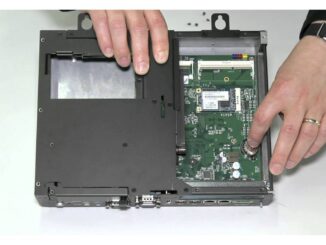
The central processing unit (CPU) is known as the brain of the computer.
It handles all the instructions your computer receives and sends and performs all the calculations required.
To know more about CPU and its parts, please keep reading the article…
[Check out – Which Laptop Component would be considered a Customer-Replaceable Unit (CRU)]
Which Part Of The Brain Holds The Computer?
As mentioned above, the computer’s brain is the central processing unit (CPU).
This is where all the calculations and decisions are made. The CPU comprises two parts, the control unit (C I) and the arithmetic logic unit (ALU).
The control unit manages the flow of information between the different parts of the computer.
The ALU performs all the arithmetic and logic operations.
My other Recent Reviews
- 10 Best Laptops Under 50000 in India 2023: Best Picks 2023 2024-06-04
- How To Disable Quick Heal Antivirus In Windows 10 2024-06-04
- What is the Speed of Computer Measured In 2024-06-03
- How To Shut Down Lenovo Laptop 2024-06-03
- How To Connect Jio Phone To Laptop 2022-10-19
What Is The Brain And Heart Of A Computer?
 Most people know that the brain is the control center for the body, and the heart is responsible for pumping blood.
Most people know that the brain is the control center for the body, and the heart is responsible for pumping blood.
But did you know that computers have brains and hearts too?
Now we all know that the brain of a computer is the central processing unit (CPU), which is responsible for executing instructions and performing operations.
Still, not everyone knows that the heart of a computer is the power supply, which provides power to all components.
Why Is The CPU Called The Brain Of The Computer
As everyone knows that what is the brain of the computer?
But did anyone ever think about why the CPU is called the brain of the computer?
Don’t worry; we’ve got it all covered because the CPU carries out all the instructions that make the computer work.
It is responsible for fetching, decoding, executing instructions, and managing data and memory.
In a modern computer, the CPU is a microprocessor.
This is a single chip that contains the control unit and ALU. The first microprocessor was the Intel 4004, which was released in 1971.
How Does The Brain Of The Computer Work?
 In the CPU, the control unit fetches instructions from memory and decodes them into a form that the ALU can understand.
In the CPU, the control unit fetches instructions from memory and decodes them into a form that the ALU can understand.
The ALU then carries out the instructions, which may involve fetching data from memory, performing calculations, or storing results in memory.
The memory is where the computer stores instructions and data. It is divided into two types: Main memory and Cache.
Main memory is composed of RAM (Random Access Memory) chips, which store data and instructions temporarily while the CPU is processing them.
A cache is a type of fast memory that stores frequently accessed data so that the CPU can quickly retrieve it.
What Are The Benefits Of Having The Brain Of The Computer?
The computer’s brain is responsible for many of the computer’s functions.
It helps to control and manage the different processes that are going on in the computer.
It also helps to keep track of information and ensure everything is running smoothly. Having the brain of the computer can be very beneficial for several different reasons.
One of the benefits of having the brain of the computer is that it can help to improve the speed of the computer.
The CPU is responsible for controlling all of the different processes that are going on in the computer.
A single control point can help ensure that everything runs as efficiently as possible. This can help to improve the overall speed of the computer.
Another benefit of having the brain of the computer is that it can help to improve the accuracy of the computer.
The CPU is responsible for keeping track of all the different pieces of information being used by the computer.
This includes things like data and instructions. Having a central location for all this information can help ensure that everything is accurate and up-to-date.
This can lead to a more accurate and reliable computer overall.
Conclusion
The brain of the computer is its central processing unit (CPU). This is where all the calculations and decision-making take place.
The CPU comprises two parts: the control unit (C U) and the arithmetic logic unit (A L U).
The control unit fetches all the instructions from memory and decodes them, while the arithmetic logic unit performs mathematical operations.
Also, we have covered much information about CPU and how it works, and we have that this article provides you with the answers to all your questions.
For more laptop-related information, please reach out to our other blog post.
Note: The below product recommendation is purely based on my particular opinion, and it does not produce to promote any individual products.




Be the first to comment